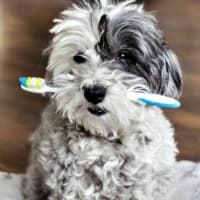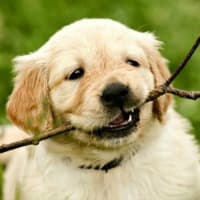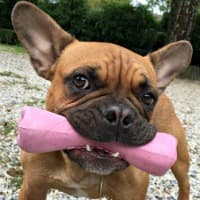Puppy Teeth - What You Need To Know
Puppy teeth may be tiny, but they're also super sharp and can cause more damage than you might expect.
Puppies use their teeth in play, to eat, in self-defense and to communicate.
You can learn all about puppy teeth HERE.
A teething puppy has a strong urge to chew on just about everything. Chewing relieves the discomfort in his gums and is also a natural stress-reliever for pups and dogs of all ages.
The eruption of the first puppy teeth, their loss, and then the subsequent emergence of the adult teeth follow a naturally occurring timeline that is very similar for puppies of all sizes/breeds.
Find out everything you've ever wanted to know about Puppy Teething!
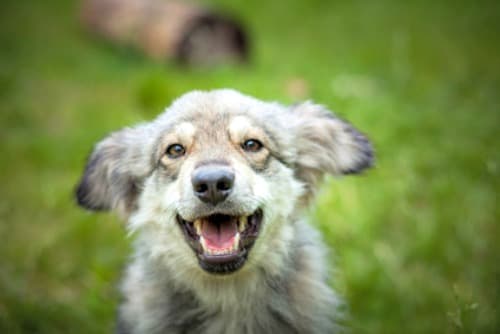
Keeping little Rascal's teeth clean and his gums healthy is an important part of his overall health care and it's a great idea to get him familiar with having his teeth brushed regularly while he's small.
Brushing those little puppy teeth is easy when you start early, and very effective at maintaining great oral health when you do it right.
About Puppy Teeth
Your puppy has twenty-eight 'baby' (Deciduous) teeth, fourteen top and fourteen bottom.
- The incisors are the tiny teeth a the front, Rascal has six upper and six lower incisors.
- The canines are the larger, pointed 'fangs'. He has two upper and two lower incisors.
- The premolars are the 'double' teeth at the back of his mouth. He has six upper and six lower premolars.
Puppies aren't born with teeth, they begin to appear somewhere between the age of two and three weeks.
- The incisors come in first at the two to three week mark.
- The canines are next at around four weeks.
- The premolars are usually in place by the time Rascal is six to eight weeks old.
Every puppy is different, and some breeds vary a little in the time-frame or order that teeth show up.
Your puppy may get his teeth a little sooner, or a little later, but the majority of puppies have all twenty eight teeth by the time they're two months old.
Puppy teeth are super sharp and very white, with shallow roots which are absorbed back into the surrounding tissue as the adult teeth push their way towards the gum.
These baby teeth are well spaced out and the gaps between them will enlarge as he grows, making room for the bigger (and more numerous) adult teeth to grow in.
Your pup will use his baby teeth to tear and grind his food, to nip and play with his siblings and to chew on anything he can find!
The 'bite' (how the top and bottom incisors fit together) varies depending on what breed (or mix thereof) your puppy is.
According to the breed standards, purebred dogs can have a variety of 'bites' - the term for the position of the front top and bottom teeth in relation to each other.
An underbite (aka 'undershot') happens when the lower jaw is longer than the upper jaw.
Bulldogs are a prime example of this type of bite dentition, and many other brachycephalic (short muzzled) dogs also have an underbite.
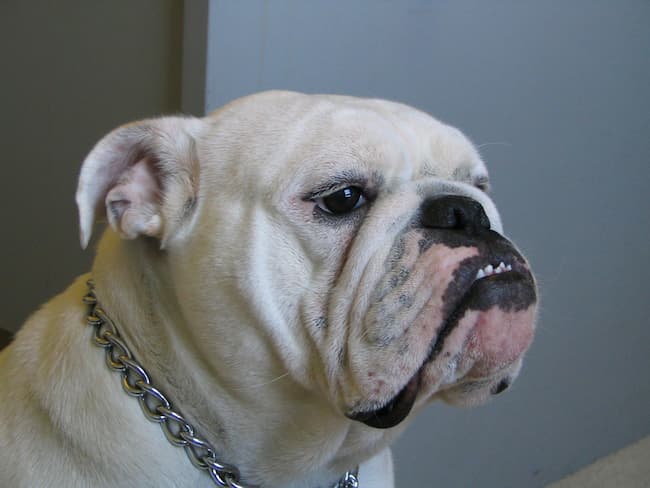
Many breeds should have a 'scissor bite', this is when the bottom incisors fit closely behind the upper ones. Imagine the way the scissor blades fit together and you'll see what I mean. Many terriers, sporting and working dogs have a scissor bite.
A 'level bite' is when the top and bottom incisors meet tip to tip, ie neither is in front of, or behind, the other.
This isn't a preferred bite for any breed, but it's acceptable in some. Having the teeth put together in this way can cause excessive wear on the edges.
Although most puppies start off with a slight overbite, as their jaws grow this changes quickly.
Being 'overshot' isn't desired in any breed and is considered a misalignment.
Many breeds, and mixed breed dogs have some degree of scissor bite, with the top front teeth fitting neatly in front of the bottom front teeth. This is normal.
Somewhere between little Rascal's third month and his fifth month, those baby puppy teeth will start to fall out.
The teething period is often uncomfortable for puppies, as his gums are tender due to the adult teeth pressing on the baby teeth to push them out. This stage lasts anywhere from two to four months on average.
Often deciduous puppy teeth come out when your little guy is eating, or chewing on a toy (or something else!).
Most of the time Rascal will be totally oblivious to the actual loss of these individual teeth, and although there may be a few spots of blood, there doesn't seem to be any pain.
Normally, as a baby tooth is pushed from his gums, the adult tooth will come in behind it, fairly quickly.
Puppies have a lot more adult teeth than they do puppy teeth, luckily their jaws are growing to accommodate this.
Adult dogs have a total of forty-two teeth consisting of twelve incisors, four canines, sixteen premolars and ten molars (six in the bottom jaw and four in the top).
'Retained' Puppy Teeth
If an adult tooth erupts through the gum and pushes itself into place without the relevant baby tooth having fallen out first your puppy will (temporarily) have a double set of that particular tooth.
This can happen with just one tooth, or with several, and it's not that unusual.
Most times the baby tooth will fall out of it's own accord within a few days, or maybe weeks. It's often loose and a little 'wiggling' of the tooth can help speed up the process.
But sometimes the baby tooth/teeth steadfastly refuse to budge, these are called retained puppy teeth.
If you notice this happening, mention it to your veterinarian who will take a look.
Your vet may suggest removing a puppy tooth which is still in place at six months of age so that no misalignment or crowding happens in little Rascal's mouth.
Having the extraction done at the same time as a neuter/spay means your pup doesn't need to have a general anesthetic twice, which is a plus, if you've decided on tooth extraction.
Large, extra large and giant breeds are better not to be spayed or neutered until somewhere between nine months and two years, depending on their breed size and developmental pattern.
If your Rascal fits in this category and also has retained puppy teeth you have a decision to make which is best discussed with your veterinarian. Ultimately the choice is yours.
The Puppy Teething Period
The period between when your little Rascal's first puppy tooth falls out and his last adult tooth grows in is the 'Teething Period'.
As with his puppy teeth, little Rascal's adult teeth are likely to appear in a certain order and although the length of the teething period can vary it usually takes around six months in total.
Most puppies follow this pattern when growing their adult teeth:
- Incisors: 2 - 5 months
- Premolars: 4 - 6 months
- Canines: 5 months
- Molars: 5 - 7 months
By the time your pup is around eight months old he should have a full set of forty-two strong, white, permanent, adult teeth.
Most puppies barely notice losing their baby teeth, if they notice it at all, but they usually do notice the discomfort from their adult teeth coming in.
Sore, itchy, tender gums are the most common problem and a natural puppy teething behavior is to chew and bite down on whatever can be found.
Puppies love to chew even when they're not teething, so this is just an escalation of that behavior, but it can get pretty intense.
The pressure your puppy feels on his gums from biting down or chewing seems to temporarily relieve the discomfort/pain of the teeth pushing through his gums.
Best Toys for Teething Puppies
Rascal will be fully focused on finding things to chew, so puppy proofing your home is important, and so is providing him with plenty of safe toys for him to exercise those jaws and teeth on.
There are a whole slew of sturdy chew toys which have been specifically designed to give him your teething puppy the relief he's looking for.
Puppy teething toys are usually made from firm but soft and flexible materials.
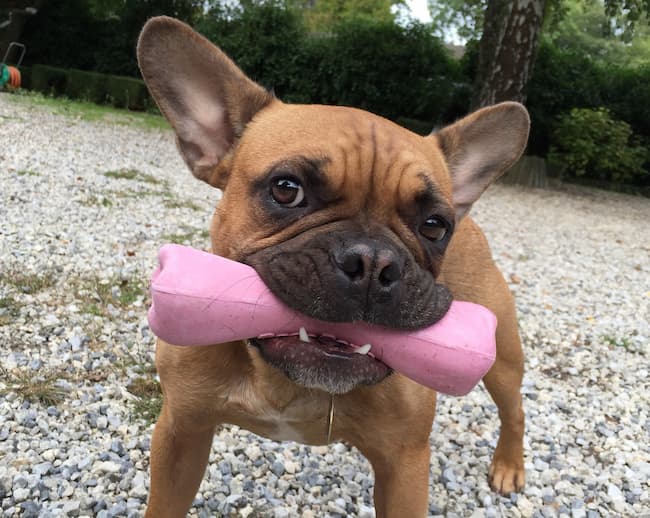
Don't give him toys made from hard, brittle or sharp materials as in his intense need to chew he could break them and hurt himself.
You'll also need to be patient and consistent in discourage him from chewing on other, unsuitable, stuff which could be dangerous in terms of choking, damage to his gums/teeth, poisonous etc.
A tried-and-tested favorite in our home is a Puppy Kong toy stuffed with Peanut butter (make sure the peanut butter doesn't contain Xylitol, check the label to be sure) or with Kong treat paste.
Freeze it for a few hours overnight and you have a cold, long-lasting and fun toy that will keep your pup busy and soothe his gums.
If you use a bigger, original Kong for this it also makes a great busy-toy for older puppies and adult dogs too (they don't have to be teething to enjoy it!).
Finding safe teething toys for puppies can be a challenge and it's important to get the right size/material/design and, or course, safety requirements.
There are lots of natural chews for puppies that will give little Rascal hours of safe and happy chomping. The majority are straight-from-nature, single ingredient chews (and many are fully digestible). They include bully sticks, yak milk chews, root chews, natural antlers and much more.
Check out my Puppy Teething Toys page to find out how to avoid dangers and toxins and choose the right toys for your little Rascal.
There are also some simple homemade puppy teething remedies which might help him feel better.
These make use of cold temperatures, pressure, and tasty incentives to help your little Rascal soothe his gums while having fun at the same time.
Ideas include frozen fruits/veggies, puppy-friendly ice-pops and more.
Learn more on my Puppy Teething Remedies page
Puppy Teething Gels
There are some teething gels available which you can try applying to your puppy's gums and see if they help.
Getting the gel onto his gums when your pup's not exactly on-board with the idea can be a challenge.
If you've been working on getting him familiar with having his mouth/teeth looked at it will be easier.
Even if you manage to get the gel onto little Rascal's gums, there's no guarantee it will make a noticeable difference, but some puppies do seem to feel more comfortable for a while afterwards.
If you decide to give this a try, Mark & Chappell Teething Gel for Puppies is a natural product containing Chamomile (naturally supports the nervous system and can relieve pain and promote relaxation), Peppermint and Clove oil.
Brushing Puppy Teeth
Your little Rascal isn't going to have his baby teeth for very long, in fact almost as soon as they're all in place he'll start losing them.
But, starting to brush your puppy's teeth early on will get him used to the feeling and the process and make it much easier for you to keep his adult teeth clean and his gums healthy.
The Veterinary Oral Health Council says that 'The key to management of gum disease... is prevention. As long as the surfaces of the teeth are cleaned frequently, the gums will stay healthy.'
Before you start actually cleaning Rascal's teeth it's a good idea to get him used to having you looking in his mouth and touching his lips, gums and teeth.
Puppies are wriggly and they have a very short attention span, so when you're handling their mouths it's important to be calm and gentle, but quick too.
Getting Rascal familiar with having his teeth examined
Start by gently lifting the little Rascal's lips at the front and touching his incisors for a few seconds.
Release him and give him a tasty treat. Do this two or three times a day for a few days or a week.
The next step is to pull up his lips at one side, then the other. Again gently touch his teeth for just a few seconds.
Release, give a treat. Repeat as above.
Finally it's time to open his mouth and look inside.
Don't force his jaws open or scare him. Gently push your thumb between his teeth at the side and lever his jaws apart gently. Take a quick look. Release him and give him a treat.
Repeat as above but gradually extend the time his mouth is open and also practice touching his teeth here and there. Once he's okay with this you're ready for tooth brushing!
Brushing your puppy's teeth isn't difficult or time consuming, but it is important so get a routine set up now and his health will benefit from it for years to come.
There are also a lot of different products you can use to keep little Rascal's teeth and gums in tip-top condition.
Check out Puppy Teeth Care for step-by-step instructions and some of the best puppy dental care products on the market.
You Might Also Like:
- Home
- About Puppy Teeth
